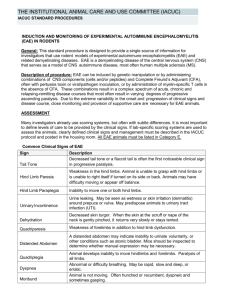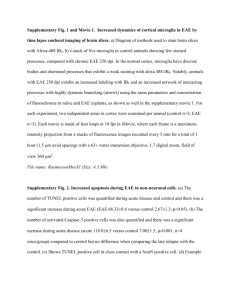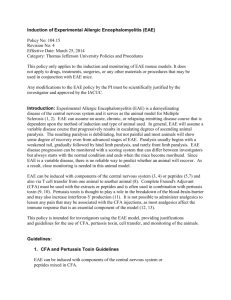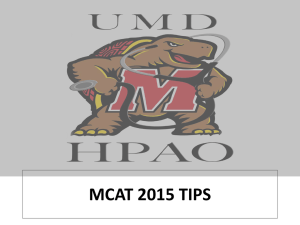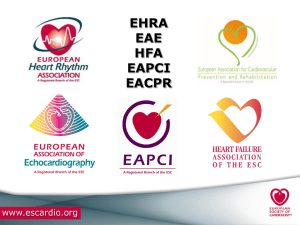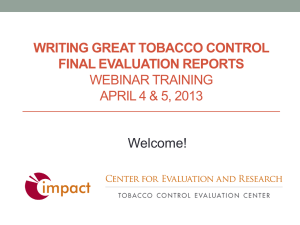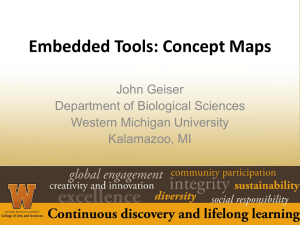EAE Model - Neuro ACF
advertisement
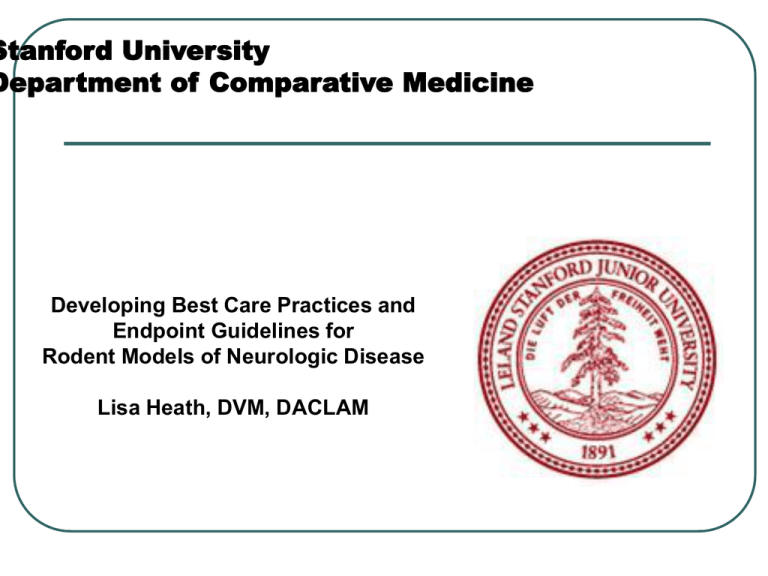
Stanford University Department of Comparative Medicine Developing Best Care Practices and Endpoint Guidelines for Rodent Models of Neurologic Disease Lisa Heath, DVM, DACLAM Rodent Models • Experimental Allergic Encephalomyelitis (EAE) • Amyotrophic Lateral Sclerosis (ALS) • Huntington’s Disease Guidelines and Endpoints Developing Guidelines • Resources • Working with Researchers Multiple Sclerosis in People Fatigue Numbness Gait, balance, coordination problems • Bowel/bladder dysfunction • Cognitive dysfunction • Pain Multiple Sclerosis Health.howstuffworks.com Multiple Sclerosis •http://www.elements4health.com/images/stories/conditions/myelin-sheath.jpg EAE Models Active EAE: immunized with myelin antigen or peptide emulsified in CFA Monophasic or relapsing-remitting disease Disease process commences 10-15 days postimmunization 75-80% incidence of disease EAE Models Passive or adoptively transferred EAE: Recipient mice injected with activated, myelin-specific T cells (harvested from immunized donor mice) Relapsing-remitting disease EAE Guidelines Benchmarking We benchmarked with other institutions to see if their IACUC had specific guidelines to cover EAE rodent models 64 institutions were surveyed regarding whether or not they had rodent EAE models • 19 institutions responded Survey Results Data and graphs courtesy of Sonja Wallace EAE Benchmarking Survey Breakdown of Respondents 5% 5% 53% University Biotech/Pharma Private Institution 11% Government 26% CRO EAE Benchmarking Survey IACUC Guidelines Specific EAE Guideline 6% 68% 26% Humane Endpoint Guideline No Guideline Specified EAE Benchmarking Survey % Weight Loss Endpoint 5% 10% Loss 5% 15% Loss 11% 20% Loss 69% 5% 5% 25% Loss 30% Loss Not Specified EAE Benchmarking Survey Separate Debilitated Animals 16% 63% Separate Don't Separate Not Specified 21% Summary Majority of respondents had an IACUC guideline specifically for EAE models Some respondents used their humane endpoint guideline for EAE models Majority of respondents used 20% percent weight loss as an endpoint Majority of respondents separated symptomatic from asymptomatic animals Refining Guidelines • Intervention/Monitoring: When and how often • Nutrition and Hydration: What, when and how often • Include the Researchers EAE Scoring Score 0 = No overt signs of disease Requirements: Label Special Request Card with “EAE Model” on Experimental Day 1 Baseline Body Weight recorded on Day 1 Assess and record scoring observations at least 3 times per week. EAE Scoring Score 1 = Limp tail, flaccidity of tail Requirements (same as for Score 0) EAE Scoring Score 2 = Paraparesis; limp tail and hindlimb weakness, waddling gait. Provide gel pack and/or moistened food on cage floor, or other appropriate supplements. Weigh and/or assess body condition score at least 3 times per week. Tail Suspension Test A. B. Normal Plantar Reflex Hindlimb Clasping Animal Welfare Information Center Bulletin, Winter 1999/2000, Vol. 10 No. 3-4 EAE Scoring Score 3 = Hindlimb paralysis. Total loss of moment in hindlimbs. Mouse moves itself with forelimbs. Daily Scoring and monitoring. Weigh and/or assess BCS at least once daily. Assess hydration status (body weight and skin turgor). Assess bladder for evidence of urinary retention. Express bladder as needed. Provide fluid supplementation, SC or oral gavage. EAE Scoring Score 4: Subdivided into 4A and 4B (for guidelines only*) 4a = Hindlimb paralysis and mild forelimb weakness 4b. Hindlimb paralysis and moderate to severe forelimb paralysis; lateral recumbency. EAE Scoring Score 4b. Hindlimb paralysis and moderate to severe forelimb paresis; lateral recumbency. Mice must be monitored at least twice daily for no more than 24 hours. Any animal that does not remit to score 3 within the time frame must be euthanized. EAE Scoring Score 5 : Moribund, or complete hindlimb paralysis with moderate to severe forelimb paresis with no remittance after 24 hrs and intensive supportive care. Euthanize immediately. EAE Scoring Any animal which loses >20% body weight or has a body condition score <2 must also be euthanized, regardless of EAE score. A Sidenote on Body Weight Recording Each mouse’s body weight data is unique No averages! Data recording: pre-disease weight and pre-calculated 20% loss cut-off EAE Scoring: Mouse Posture 0 : Tail has tone. 1: Tail no longer stands up, loss of tail tone. Walks normally. 2: Limp tail, hindlimb dysfunction. 3: No longer holds onto underside of cagelid with hindlimbs. Moves hindlimbs. Current Protocols in Neuroscience 4: Hindlimbs drag behind, not used for movement. EAE Scoring Models of Multiple Sclerosis. ACNR. Vol 6. No 6. 2007 Amyotrophic Lateral Sclerosis Fatal neurodegenerative disease Familial and Sporadic Lou Gehrig’s Disease Loss of upper and lower motor neurons Paralysis of muscles www.alsa.org ALS Models SOD1 mice ALS Mouse Models Muscle atrophy Weight loss Limb weakness and paralysis Oral and pharyngeal dysphagia Respiratory weakness and paralysis ALS Scoring System Score Full extension of hind legs away from lateral of 0 midline when mouse is suspended by its tail, and mouse can hold this for two seconds, suspended two or three times. Score Collapse or partial collapse of leg extension of 1 towards lateral midline (weakness) or trembling of hind legs during tail suspension. Score Toes curl under at least twice during walking of of 2 12 inches, or any part of foot is dragging along cage bottom/table.* Score Rigid paralysis or minimal joint movement, foot of 3 not being used for generating forward motion. Score Mouse cannot right itself within 30 seconds after of 4 being placed on either side. Working with ALS Mice: Guidelines for preclinical testing & colony management. The Jackson Laboratory ALS Scoring System *If one hind leg is scored as 2, food pellets are left on bedding. If both hind legs are scored as 2, Nutra-Gel is provided as food in addition to food pellets on bedding and a long sipper tube is placed on the water bottle. Working with ALS Mice: Guidelines for preclinical testing & colony management. The Jackson Laboratory ALS Scoring System:: 8 Point Scale CS 0 CS 1 CS1.5 CS2* No evidence of disease Shaking or splaying of hind legs when suspended by tail Weakness in one hind leg Change in gait (used as disease onset when attained on two consecutive days *disease onset CS 2.5 Extreme weakness in one hind leg (inability to dorsiflex) CS 3 Extreme weakness in both hind leg CS 3.5 Functional paralysis in one hind leg Solomon, et.al. One Universal Common Endpoint in Mouse Models of Amyotrophic Lateral Sclerosis. June 2011, vol. 6, issue 6. Endpoint Scoring for ALS: 8 Point Scale CS4 Both hind legs functionally paralyzed CS4+ CS4 plus the earliest time mice attained one of the following: a) weight loss > 20% vs. body weight immediately prior to a clinical score of 2* b) weight loss > 20% vs. peak body weight c) body condition score <2 d) righting reflex > 20s (clinical score of 5) CS5 CS 4 plus a righting reflex >20s Huntington’s Disease Huntington’s Disease Scoring: Part 1 Score of 0 Normal Score of 1 Clasps hind limbs within 30s of being suspended Score of 2 Clasps hind limbs within 5s but recovers quickly after 30s Score of 3 Clasps hind limbs within 5s, difficulty recovering when released after 30s Auerbach, et.al. Human Molecular Genetics, 2001, Vol. 10, No. 22. Huntington’s Disease Scoring: Movement Abnormalities Tail stiffness or paralysis Hind-limb stiffness or paralysis Reduced left-right alteration of hindlimbs (“hopping”) Resting tremors Difficulties walking after handling Seizure-like episodes Huntington’s Disease Scoring: Part 2 Score of 0 Normal Score of 1 One movement abnormality Score of 2 Two movement abnormalities Score of 3 Three movement abnormalities Huntington’s Disease Scoring: Combining Part 1 and 2 Scores range from 0:0 (normal, no disease) to 3:3 (greatest expression of clinical signs) Choose score/score combinations for adding care : • • food and water accessibility, supplements heat source, nesting materials Huntington’s Disease Reference: Guyenet, et.al. (2010). A Simple Composite Phenotype Scoring System for Evaluating Mouse Models of Cerebellar Ataxia. JoVE. 39. ID 1787. Tests: ledge test, hindlimb clasping, gait, kyphosis Huntington’s Disease Noise sensitivity: construction, cage changes, hoods and ventilation Seizure-like activity and deaths related to noise and other disturbances Hypothermia in late stage disease: external heat source; nestlets vs. paper nesting material Enviro-dri® (Shepherd Specialty Papers) www.ssponline.com Summary Meet with investigators: look at their scoring and weight data Provide specific solutions and options Include investigators on guidelines development
